Scottish Terrier
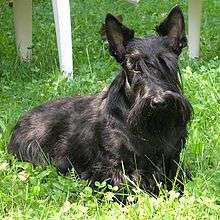 A black Scottish Terrier | |||||||||||||||||||||||||||||||||
| Common nicknames | Scottie, Aberdeenie | ||||||||||||||||||||||||||||||||
|---|---|---|---|---|---|---|---|---|---|---|---|---|---|---|---|---|---|---|---|---|---|---|---|---|---|---|---|---|---|---|---|---|---|
| Origin | Scotland | ||||||||||||||||||||||||||||||||
| |||||||||||||||||||||||||||||||||
| |||||||||||||||||||||||||||||||||
| Notes | National dog of Scotland | ||||||||||||||||||||||||||||||||
| Domestic dog (Canis lupus familiaris) | |||||||||||||||||||||||||||||||||
The Scottish Terrier (also known as the Aberdeen Terrier), popularly called the Scottie, is a breed of dog. Initially one of the highland breeds of terrier that were grouped under the name of Skye Terrier, it is one of five breeds of terrier that originated in Scotland, the other four being the modern Skye, Cairn, Dandie Dinmont, and West Highland White Terrier. They are an independent and rugged breed with a wiry outer coat and a soft dense undercoat. The First Earl of Dumbarton nicknamed the breed "the diehard". The modern breed is said to be able to trace its lineage back to a single female, named Splinter II.
They are a small breed of terrier with a distinctive shape and have had many roles in popular culture. They have been owned by a variety of celebrities, including the 32nd President of the United States, Franklin Delano Roosevelt, whose Scottie "Fala" is included with FDR in a statue in Washington, D.C., as well as the 43rd President George W. Bush. They are also well known for being a playing piece in the board game Monopoly. Described as a territorial, feisty dog, they can make a good watchdog and tend to be very loyal to their family. Healthwise, Scottish Terriers can be more prone to bleeding disorders, joint disorders, autoimmune diseases, allergies, and cancer than some other breeds of dog and there is a condition named after the breed called Scotty cramp. They are also one of the more successful dog breeds at the Westminster Kennel Club Dog Show with a recent best in show in 2010.
Description
Appearance



The Scottish Terrier is a small, compact, short-legged, sturdily-built terrier of good bone and substance. They have a hard, wiry, weather-resistant coat and a thick-set, cobby body which is hung between short, heavy legs. These characteristics, joined with his very special keen, piercing, "varminty" expression, and his erect ears and tail are salient features of the breed. The Scottish Terrier's bold, confident, dignified aspect exemplifies power in a small package. The eyes should be small, bright and piercing, and almond-shaped not round. The color should be dark brown or nearly black, the darker the better. The ears should be small, prick, set well up on the skull and pointed, but never cut. They should be covered with short velvety hair.[1]
Height at withers for both genders should be roughly 25 cm (9.8 in), and the length of back from withers to tail is roughly 28 cm (11 in). Generally a well-balanced Scottie dog should weigh from 8.5 to 10 kg (19 to 22 lb) and a female from 8 to 9.5 kg (18 to 21 lb). It is about 10 to 11 inches (25 to 28 cm) in height.[2]
Coat
The Scottish Terrier typically has a hard, wiry outer coat with a soft, dense undercoat. The coat should be trimmed and blended into the furnishings to give a distinct Scottish Terrier outline. The longer coat on the beard, legs and lower body may be slightly softer than the body coat but should not be or appear fluffy.[1]
The coat colours range from dark gray to jet black and brindle, a mix of black and brown. Scotties with wheaten (straw to nearly white) coats sometimes occur, and are similar in appearance to the Soft-Coated Wheaten Terrier or West Highland White Terrier.
Temperament
Scotties are territorial, alert, quick moving and feisty, perhaps even more so than other terrier breeds. The breed is known to be independent and self-assured, playful, intelligent and has been nicknamed the 'Diehard' because of its rugged nature and endless determination.[3] The "Diehard" nickname was originally given to it in the 19th century by George, the fourth Earl of Dumbarton.[4] The Earl had a famous pack of Scottish Terriers, so brave that they were named “Diehards”. They were supposed to have inspired the name of his Regiment, The Royal Scots, "Dumbarton’s Diehards".[4]
Scotties, while being described as very loving, have also been described as stubborn.[5] They are sometimes described as an aloof breed, although it has been noted that they tend to be very loyal to their family and are known to attach themselves to one or two people.[6]
It has been suggested that the Scottish Terrier can make a good watchdog due to its tendency to bark only when necessary and because it is typically reserved with strangers, although this is not always the case.[3] They have been described as a fearless breed that may be aggressive around other dogs unless introduced at an early age.[7] Scottish Terriers were originally bred to hunt and fight badgers. Therefore, the Scottie is prone to dig as well as chase small vermin, such as squirrels, rats, and mice.[7]
Health
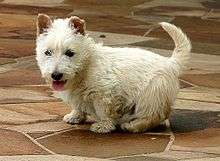
Two genetic health concerns seen in the breed are von Willebrand disease (vWD) and craniomandibular osteopathy (CMO); Scottie cramp, patellar luxation and cerebellar abiotrophy are also sometimes seen in this breed. Common eye conditions seen in a variety of breeds such as cataracts and glaucoma can appear in Scotties as they age. There are no specific conditions relating the skin that affect the breed, but they can be affected by common dog related conditions such as parasites and mange.[8] Scotties typically live from 11 to 13 years.[9]
Cancer in Scottish Terriers
Scottish Terriers have a greater chance of developing some cancers than other purebreds. According to research by the Veterinary Medical Data Program (1986), six cancers that Scotties appeared to be more at risk for (when compared to other breeds) are: (in descending order) bladder cancer and other transitional cell carcinomas of the lower urinary tract; malignant melanoma; gastric carcinoma; squamous cell carcinoma of the skin; lymphosarcoma and nasal carcinoma.[10] Other cancers that are known to commonly affect Scotties include mast cell sarcoma[11] and hemangiosarcoma.[12]
Research has suggested that Scottish Terriers are 20 times more likely to get bladder cancer than other breeds[13] and the most common kind of bladder cancer is transitional cell carcinoma of the bladder (TCC).[10] Dr. Deborah Knapp of Purdue University School of Veterinary Medicine has commented "TCC usually occurs in older dogs (average age 11 years) and is more common in females (2:1 ratio of females to males)."[10] Symptoms of TCC are blood in the urine, straining to urinate, and frequent urination—although owners noticing any of these symptoms should also be aware that the same symptoms may also be indicative of a urinary tract infection.[10]
The most common and effective form of treatment for TCC is Piroxicam, a non-steroidal anti-inflammatory drug that "allows the cancer cells to kill themselves."[10] In order to help prevent cancer in a dog, an owner should ensure that their dog has minimal exposure to herbicides, pesticides, solvents and cigarette smoke; use caution when treating dogs with some flea medications; provide a healthy, vitamin-rich diet (low in carbohydrates, high in vegetables) and plenty of exercise.[14]
Scottie cramp
Scottie cramp is an autosomal recessive hereditary disorder which inhibits the dog's ability to walk. It is caused by a defect in the pathways in the brain that control muscle contraction due to a low level of serotonin in the body.[15] Typically symptoms only show when the particular dog is under some degree of stress. The front legs are pushed out to the side, the back arches and the rear legs overflex, causing the dog to fall should they be moving at speed. The condition is not seizure related, and the dog remains conscious throughout the event, with symptoms abating once the cause of the stress has been removed.[16]
Vitamin E, Diazepam and Prozac have all been shown to be effective treatments should it be required. Scotty cramp is found in other breeds of terrier, including the Cesky Terrier.[16] "Episodic Falling", a condition found in Cavalier King Charles Spaniels is considered to be similar to this disorder.[17]
Craniomandibular osteopathy
Also known as "Lion Jaw", "Westy Jaw" or "Scotty Jaw", this condition of craniomandibular osteopathy is caused by excessive bone growth in the bottom jaw, usually occurring between four and seven months of age. Like Scottie Cramp, it is an autosomal recessive hereditary disorder, and can cause discomfort to the dog when it attempts to chew.[18] The progression of the condition usually slows down between eleven and thirteen months of age, and is sometimes followed by a slow partial or complete regression.[19]
This condition has also been seen in other breeds of dog, such as the West Highland White Terrier, Cairn Terrier, Boston Terrier,[20] as well as some larger breeds such as Bullmastiffs.[21]
von Willebrand's disease
Von Willebrand's disease is a hereditary bleeding disorder found in both dogs and humans. It is caused by a lack of von Willebrand factor which plays a role in the clotting process of blood. This can cause abnormal platelet function and prolonged bleeding times. Affected dogs can be prone to nose bleeds, and increased bleeding following trauma or surgery. There are three types of this condition with Type I being the most common, while Type II and III being rarer, but more severe. Type I von Willebrand's disease is relatively common in the Scottish Terrier.[22]
Type I is more widespread in Doberman Pinscher, but is as common in the Shetland Sheepdog as the Scottish Terrier. The condition appears in most breeds to some extent, but other breeds with an increased risk include the Golden Retriever, German Shepherd Dog, Basset Hound and Manchester Terrier.[22]
History
Initial grouping of several of the highland terriers (including the Scottie) under the generic name Skye Terriers caused some confusion in the breed’s lineage. There is disagreement over whether the Skye Terriers mentioned in early 16th century records actually descended from forerunners of the Scottie or vice versa.[23] It is certain, however, that Scotties and West Highland White Terriers are closely related—both their forefathers originated from the Blackmount region of Perthshire and the Moor of Rannoch.[24] Scotties were originally bred to hunt and kill vermin on farms and to hunt badgers and foxes in the Highlands of Scotland.[25]
The actual origin of a breed as old as the Scottish Terrier is obscure and undocumented.[26] The first written records about a dog of similar description to the Scottish Terrier dates from 1436, when Don Leslie described them in his book The History of Scotland 1436–1561. Two hundred years later, Sir Joshua Reynolds painted a portrait of a young girl caressing a dog similar in appearance to the modern-day Scottie.[4] King James VI of Scotland was an important historical figure featuring in the Scottish Terrier's history. In the 17th century, when King James VI became James I of England, he sent six terriers—thought to be forerunners of the Scottish terrier—to a French monarch as a gift.[6] His love and adoration for the breed increased their popularity throughout the world.[23]
Many dog writers after the early 19th century seem to agree that there were two varieties of terrier existing in Britain at the time—a rough-haired so-called Scotch Terrier and a smooth-haired English Terrier.[26] Thomas Brown, in his Biological Sketches and Authentic Anecdotes of Dogs (1829), states that "the Scotch terrier is certainly the purest in point of breed and the (smooth) English seems to have been produced by a cross from him".[26] Brown went on to describe the Scotch Terrier as "low in stature, with a strong muscular body, short stout legs, a head large in proportion to the body" and was "generally of a sandy colour or black" with a "long, matted and hard" coat.[26] Although the Scotch Terrier described here is more generic than specific to a breed, it asserts the existence of a small, hard, rough-coated terrier developed for hunting small game in the Scottish Highlands in the early 19th century; a description that shares characteristics with what was once known as the Aberdeen Terrier and is today known as the Scottish Terrier. In addition, the paintings of Sir Edwin Landseer and an 1835 lithograph entitled "Scottish Terriers at Work on a Cairn in the West Highlands" both depict Scottie type terriers very similar to those described in the first Scottish Terrier Standard.[4]
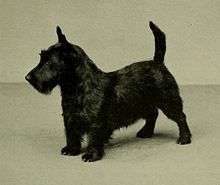
In the 19th century, the Highlands of Scotland, including the Isle of Skye, were abundant with terriers originally known by the generic term "short-haired terriers" or "little Skye Terriers."[27] Towards the end of the 19th century, it was decided to separate these Scottish terriers and develop pure bloodlines and specific breeds. Originally, the breeds were separated into two categories: Dandie Dinmont Terriers and Skye Terriers (not the Skye Terrier known today, but a generic name for a large group of terriers with differing traits all said to originate from the Isle of Skye). The Birmingham England dog show of 1860 was the first to offer classes for these groups of terriers.[26] They continued to be exhibited in generic groups for several years and these groups included the ancestors of today's Scottish Terrier.[26] Recorded history and the initial development of the breed started in the late 1870s with the development of dog shows. The exhibition and judging of dogs required comparison to a breed standard and thus the appearance and temperament of the Scottie was written down for the first time.[4] Eventually, the Skye Terriers were further divided into what are known today as the Scottish Terrier, Skye Terrier, West Highland White Terrier and Cairn Terrier.[27]
While fanciers sought to identify and standardize the breed and its description through the late 19th century, the Scottish Terrier was known by many different names: the Highland, the Cairn, Diehard, and most often, the Aberdeen Terrier—named because of the abundant number of the dogs in the area and because a J. A. Adamson of Aberdeen successfully exhibited his dogs during the 1870s.[26] Roger Rough, a dog owned by Adamson, Tartan, a dog owned by Mr Paynton Piggott, Bon Accord, owned by Messrs Ludlow and Bromfield, and Splinter II owned by Mr Ludlow, were early winners of dog exhibitions and are the four dogs from which all Scottish Terrier pedigrees ultimately began.[4] It is often said that all present day Scotties stem from a single bitch, Splinter II, and two sires. In her book, The New Scottish Terrier, Cindy Cooke refers to Splinter II as the "foundation matron of the modern Scottish Terrier." Cooke goes on to say "For whatever reason, early breeders line bred on this bitch to the virtual exclusion of all others. Mated to Tartan, she produced Worry, the dam of four champions. Rambler, her son by Bonaccord, sired the two founding sires of the breed, Ch. Dundee (out of Worry) and Ch. Alistair (out of a Dundee daughter)"[28] Show champions on both sides of the Atlantic descend from Splinter and her sires.[29]
Captain Gordon Murray and S.E. Shirley were responsible for setting the type in 1879.[24] Shortly afterwards, in 1879, Scotties were for the first time exhibited at Alexander Palace in England, while the following year they began to be classified in much the same way as is done today.[30] The first written standard of the breed was drafted by J.B. Morrison and D.J. Thomson Gray and appeared in Vero Shaw's Illustrated Book of The Dog, published in 1880; it was extremely influential in setting both breed type and name. The standard described the breed's colouring as "Grey, Grizzle or Brindle", as the typically Black colouring of Scotties did not become fashionable or favoured until the 20th century.[26]
In 1881 the "Scottish Terrier Club of England" was founded, being the first club dedicated to the breed. The club secretary, H.J. Ludlow, is responsible for greatly popularising the breed in the southern parts of Great Britain. The "Scottish Terrier Club of Scotland" was not founded until 1888, seven years after the English club.[30] Following the formation of the English and Scottish clubs there followed several years of disagreement regarding the breed's official standard.[30] The issue was finally settled by a revised standard in 1930, which was based on four prepotent dogs. The dogs were Robert and James Chapman's Heather Necessity, Albourne Barty, bred by AG Cowley, Albourne Annie Laurie, bred by Miss Wijk and Miss Wijk's Marksman of Docken (the litter brother of Annie Laurie).[4] These four dogs and their offspring modified the look of the Scottie, particularly the length of the head, closeness to the ground and the squareness of body. Their subsequent success in the show ring led to them becoming highly sought after by the British public and breeders. As such, the modified standard completely revolutionized the breed.[4] This new standard was subsequently recognised by the Kennel Club UK circa 1930.[30]
Scotties were introduced to America in the early 1890s, but it was not until the years between World War I and World War II that the breed became popular. The Scottish Terrier Club of America (STCA) was formed in 1900[31] and a standard written in 1925.[4] The Scottish Terrier was recognized by the United Kennel Club in 1934.[32] By 1936, Scotties were the third most popular breed in the United States. Although they did not permanently stay in fashion, they continue to enjoy a steady popularity with a large segment of the dog-owning public across the world.[33] The STCA founded its Health Trust Fund (HTF) in 1995 which supports research on health issues in the breed.
Scottish Terriers have won best in show at the Westminster Kennel Club Dog Show more than any other breed except for the Wire Fox Terrier, a total of nine times.[34] These victories began in 1911 with a win by Ch. Tickle Em Jock and include recent victories such as in 1995 when Ch. Gaelforce Post Script (Peggy Sue) won, and in 2010 with a victory by Ch. Roundtown Mercedes Of Maryscot.[35][36]
Famous Scotties and popular culture
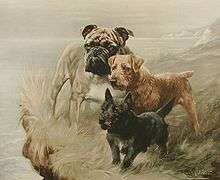
The Scottie and the German Shepherd are the only breeds of dog that have lived in the White House more than three times.[37] President Franklin D. Roosevelt was renowned for owning a Scottie named Fala, a gift from his distant cousin, Margaret Suckley.[38] The President loved Fala so much that he rarely went anywhere without him. Roosevelt had several Scotties before Fala, including one named Duffy and another named Mr. Duffy. Eleanor Roosevelt had a Scottish Terrier named Meggie when the family entered the White House in 1933.[38] More recently, President George W. Bush has owned two black Scottish Terriers, Barney and Miss Beazley. Barney starred in nine films produced by the White House.[39]
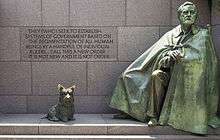
Other famous people who are known to have owned Scotties include: Queen Victoria, Eva Braun, Dwight D. Eisenhower, Jacqueline Kennedy Onassis, Ed Whitfield, Rudyard Kipling and President of Poland, Lech Kaczynski.[40] Actress Tatum O'Neal owned a Scottish Terrier. She was said to be so saddened by her dog's death to cancer and old age that she relapsed into drugs.[41]
The Scottie is also renowned for being featured in the popular board game, Monopoly, as a player token. When the game was first created in the 1930s, Scotties were one of the most popular pets in the United States, and it is also one of the most popular Monopoly game tokens, according to Matt Collins, vice president of marketing for Hasbro.[42] A Scottish Terrier named Dulcinea is a scene-stealer in the 1998 Latin American novel Yo-Yo Boing! by Giannina Braschi.[43]
In May 2007, Carnegie Mellon University named the Scottish Terrier its official mascot.[44] The Scottie had been a long-running unofficial mascot of the university, whose founder's Scottish heritage is also honored by the official athletic nickname of "Tartans".[45] Agnes Scott College in Decatur, Georgia also uses the Scottie as their mascot.[46] The dog's image is a symbol for the Radley brand of bags.[47] The amateur athletics organisation Jogscotland has an anthropomorphic Scottish Terrier as its mascot.[48]
See also
- List of domesticated Scottish breeds
- Scotty dog sign (radiological term)
References
- 1 2 "STCA_Breed_Standard". Retrieved 19 July 2012.
- ↑ Cunliffe, Juliette (2002). The Encyclopedia of Dog Breeds. Parragon. p. 248. ISBN 0-7525-8018-3.
- 1 2 "Scottish Terrier". Dog-Breed-Facts.com. Retrieved 2008-08-13.
- 1 2 3 4 5 6 7 8 9 "History of the Scottish Terrier". MacTavish Scotties. Retrieved 2008-08-13.
- ↑ "Terrier Dog Breeds". Buzzle.com. Retrieved 2015-02-17.
- 1 2 "The Scottish Terrier". Dog Owner's Guide. Retrieved 2009-08-14.
- 1 2 Jones, Jewel R. "Profile of the Scottish Terrier". BarkBytes. Retrieved 2008-08-13.
- ↑ "Overview of serious health conditions in Scottish terrier breed". Scottish Terrier Dog.com. Retrieved 2010-02-18.
- ↑ Coile, Caroline (2005). Encyclopedia of Dog Breeds. Barron's Educational Series. p. 198. ISBN 978-0-7641-5700-4.
- 1 2 3 4 5 Fry Owen, Carole. "CANCER: The Scottish Terrier's War On Terror". Tartanscottie.com. Retrieved 2008-08-13.
- ↑ Morrison, Wallace B. (1998). Cancer in Dogs and Cats (1st ed.). Williams and Wilkins. ISBN 0-683-06105-4.
- ↑ "Protecting your dog from cancer". scottiecancer.com. Retrieved 2008-08-13.
- ↑ "Bladder Cancer in the Scottish Terrier". North of England Scottish Terrier Club. Archived from the original on June 6, 2008. Retrieved 2008-08-13.
- ↑ "10 steps to protect your pet from cancer". scottiecancer.com. Retrieved 2008-08-13.
- ↑ "What is Scotty Cramp?". Canine Inherited Disorders Database. 2001-10-30. Retrieved 2010-02-07.
- 1 2 "Scottie Cramp". Cesky Terrier.co.uk. Retrieved 2010-02-07.
- ↑ Slatter, Douglas H. Textbook of Small Animal Surgery (3rd ed.). W.B. Saunders Company. p. 1094. ISBN 978-0-7216-8607-3.
- ↑ Vanderlip, Sharon Lynne (2001-08-31). Scottish Terriers. Barron's Educational Series. p. 81. ISBN 978-0-7641-1639-1. Retrieved 2010-02-08.
- ↑ "Craniomandibular Osteopathy (CMO): Page 3". PetPlace.com. Retrieved 2010-02-18.
- ↑ Ettinger, Stephen J.; Feldman, Edward C. (1995). Textbook of Veterinary Internal Medicine (4th ed.). W.B. Saunders Company. ISBN 0-7216-6795-3.
- ↑ Huchkowsky S (2002). "Craniomandibular osteopathy in a bullmastiff". Can Vet J. 43 (11): 883–5. PMC 339767
 . PMID 12497967.
. PMID 12497967. - 1 2 "What is von Willebrand's disease?". Canine Inherited Disorders Database. 2001-10-30. Retrieved 2010-02-18.
- 1 2 Ruben, Dawn. "Choosing a Scottish Terrier". Pet Place. Retrieved 2010-01-01.
- 1 2 "Scottish Terrier". Pet Planet. Retrieved 2010-01-01.
- ↑ "Scottish Terrier". Pedigree.com.au. Retrieved 2015-08-03.
- 1 2 3 4 5 6 7 8 Stamm, Miriam; Beauchamp, Rick (1998). An Owner's Guide to Scottish Terriers. TFH Publications. ISBN 978-0-7938-2786-2.
- 1 2 "Choosing a Cairn Terrier". Pet Place. Retrieved 2010-01-01.
- ↑ Harvil, Joseph. "Deconstructing the Diehard" (PDF). Great Scots Magazine. Retrieved 2010-01-01.
- ↑ Graham, Claribel. "The Origin of the Scottish Terrier". Scottish Terrier Club of America. Retrieved 2012-07-12.
- 1 2 3 4 "Scottish Terrier: About Breed". PasOddy.com. Retrieved 2010-01-01.
- ↑ Barrie, Carswell. "History". Scottish Terrier Club of America. Retrieved 8 March 2015.
- ↑ "Scottish Terrier". United Kennel Club. Archived from the original on 8 March 2015. Retrieved 2010-01-01.
- ↑ "Guide to the Scottish Terrier Club of America Collection (1902-2005)". Retrieved 19 July 2012.
- ↑ "Best In Show Awards By Breed (1907-2009)". The Westminster Kennel Club. Retrieved 2010-02-17.
- ↑ "Scottie is Best Dog in U.S.". Life. 26 February 1945. p. 65. Retrieved 2010-03-05.
- ↑ "Best in Show Winners". The Westminster Kennel Club. Retrieved 2010-02-17.
- ↑ "Scottish Terrier: History". PasOddy.com. Retrieved 2010-01-01.
- 1 2 "FDR's Fala, World's Most Famous Dog". Bushy Barney. Retrieved 2010-01-01.
- ↑ "Barney's Home Page". The White House. Retrieved 2010-01-01.
- ↑ Huber, Vandra L. "Famous People Owned by Scottish Terriers" (PDF). Mcvan Scotties. Retrieved 2010-01-01.
- ↑ "Tatum O'Neal says her dog's death triggered her drugs arrest". Welt Online. 2008-06-04. Retrieved 2010-01-01.
- ↑ Ward, Julie (2006-09-18). "Move over, Rover: Hybrid labradoodle replaces Scottish terrier token". USA Today. Retrieved 2010-01-01.
- ↑ Braschi, Giannina (1998). Yo-Yo Boing!. Seattle: AmazonCrossing. pp. 50, 52, 53, 79, 118, 190. ISBN 161109089X. Retrieved April 20, 2013.
- ↑ "Carnegie Mellon Family Will Get a Dog". Carnegie Mellon. Retrieved 2010-01-01.
- ↑ Schackner, Bill (2007-01-29). "CMU dogs it on picking a mascot". Pittsburgh Post-Gazette. Retrieved 2010-01-01.
- ↑ "Photos from Alumnae Weekend 2008". Agnes Scott College. Retrieved 2010-01-01.
- ↑ Craven, Neil (8 February 2009). "London pride at Radley". The Mail on Sunday. via HighBeam Research (subscription required). Retrieved 14 April 2012.
- ↑ "Jogscotland: Meet the Jog Crew". Jogscotland. Retrieved 2013-01-25.
External links
| Wikimedia Commons has media related to Scottish Terrier. |